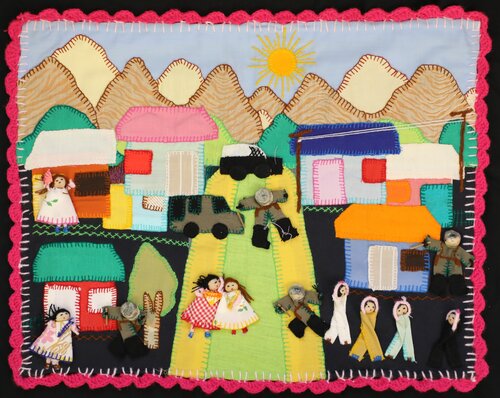
The Pinochet dictatorship that swept into Chile in 1973 saw a promising democracy thrust into the hands of a brutal dictator bent on suppressing opposition to his rule. Nearly 3,000 Chilean citizens were directly murdered by the Pinochet regime, with many more imprisoned, tortured, or made to disappear. The atmosphere created by the dictatorship was one of fear and silence, for dissent was actively oppressed. Those labeled as “leftists” or “labor unionists” were targeted, and in some cases abducted by the regime in order to suppress what the regime viewed as an ideological risk to the stability of its fascist policy. Despite this, Chilean women found ways to express themselves and to clandestinely transport testaments to the brutality of the regime outside of Chile and to the rest of the world. Arpilleras, traditionally rooted in folk art of the Chilean countryside, became carriers bearing images of the brutal oppression of the Pinochet regime. These “tapestries of defamation” as Pinochet deemed them, painted a picture of the government that the regime greatly detested. The dictatorship made significant efforts to limit the development and circulation of arpilleras in Chile. They were rather successful, though the regime was unable to foil their creation, as the artists were protected by the Chilean catholic church, and formed arpillera workshops within church buildings themselves. Only through church shops, chiefly protected by La Vicaria de la solidaridad, were arpilleras purchased, and they mostly found themselves in the hands of academics or American tourists who frequented these cultural attractions.
Though ideologically devastating for the Pinochet dictatorship, arpilleras held a much more significant monetary value for the working class women who made them. Under the Pinochet regime, economic inequality was exasperated. Economic reforms revamped the economy and spurred development in many sectors. However, this often came at the expense of the lower classes and to the benefit of elites, worsening the wealth gap immensely. Impoverished classes had to seek alternative streams of income with increasing poverty rates, and one way impoverished women found to do so was produce arpilleras and sell them. They found popularity amongst foreigners and were made in most cases only to be sold, not to implicitly challenge the Pinochet dictatorship as propaganda, but as testaments to the cruelty and oppression of the regime that could be purchased to support those it sought to put down.
In these vibrantly colorful works, dramatic scenes of the regime in action are simplified and convey the stark emotions of the scenario at hand. In this arpillera from 1976, the atmosphere of the Chilean urban regions is one of strict control and oppression. In the arpillera, soldiers are clearly distinguished in their green fatigues as they move in and out of houses, rounding up civilians suspected of dissent. As was often the case, in this arpillera, the men are led away with their hands on their heads while the women, depicted with wide skirts, are left to their own devices in an increasingly impoverished struggle to maintain their way of life. Subsequently, with many breadwinners abducted by the Pinochet regime, many women who no longer had husbands and sons to work for the family turned to the arpillera workshops to make a living for themselves and their families. As shown in its themes, arpilleras reflect the lived experiences of their makers, and serve as candid and evocative artifacts to the lives affected by the Pinochet regime.
Works Cited
“Arte, Mujer y Memoria: Arpilleras from Chile – MOLAA: Museum of Latin American Art.” MOLAA. MOLAA, November 24, 2019. https://molaa.org/arte-mujer-memoria-exhibition.
McCraken, Sarah. “ARPILLERAS: A VISUAL HISTORY OF THE POOR UNDER PINOCHET.” PROSPECT. Prospect Journal UCSD, August 25, 2011. https://prospectjournal.org/2011/08/24/arpilleras-a-visual-history-of-the-poor-under-pinochet/.
Image Link: https://molaa.org/arpilleras-online-aftermath
